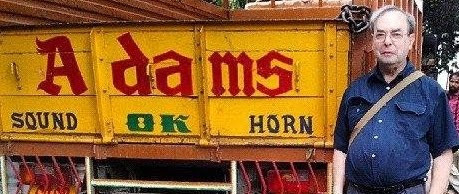Even during the coolest time of the year, the temperature in the plains in the south of India can exceed 30 degrees Celsius. In summer, the sky's the limit! As the summer temperature soared in the plains during the 19th century, Europeans sought refuge from the heat in so-called 'hill-stations'. These included members of the American Madura Mission, who decided to set up their own hill-station in Kodaikanal. The Americans built their first church (illustrated above: picture from a 1909 guidebook) there in 1857. It was used for services until 1896 when a new church was built . By 1908, the original church had been demolished. Today, all that remains of this is an obelisk in the midst of the overgrown American Cemetery:
The cemetery is close to one of the earliest dwellings - if not the earliest - to have been built by the American Missionaries:
This building is still privately owned by some Americans and is, like the other remaining original building, built without foundations. The successor to the original church is the Union Church, which is near one of the entrances to Coaker's Walk:
We noticed a wall-mounted clock inside the church. It looked quite old, and had been supplied by a company in Madras, but had been made in the USA:
The Americans were not the only non-British 'Europeans' to settle in Kodaikanal. They were joined by Swedes and Germans. Scarcely anything remains of the Swedish settlement apart from an indication of its location on a map issued by Tamil Nadu Tourism at the rather basic tourist office on PT Road, which is almost opposite a small, super short-order restaurant called Pot Luck. The German Missionary Church stlll stands alongside its separate wooden bell-tower and is in good condition:
Two stone crosses surrounded by a circle of thorns stand near to the bell-tower. They are without inscriptions. Maybe, they mark graves. It is difficult to say whether this is the case.
A commemorative stone in the church's south wall reads as follows:
Sadly, I cannot find any information about this pastor G Lohmann on the Internet. This old church, which we were unable to enter, is not the only Lutheran church in Kodaikanal. There is another one opposite the main buildings of Koadikanal International School:
Within the grounds of Kodaikanal International School ('KIS'), which were priviliged to be shown around, we saw another of the town's churches. The construction of the school's chapel began in the 1930s. It is named in honour of the school's first Principal Margaret Eddy (1848-1935)
The school was founded at the beginning of the 20th century by members of several missions. Roughly 50% of its about 600 students come from outside India.
The KIS is close to a complex of restaurants that includes a pizza outlet. There is nothing surprising about this in a town with so many students, but the pious exhortations on the signboard outside it are unusual:
Maybe, we should not be so surprised as a missionary atmosphere does seem to pervade the town.
We visited two other churches in the town. One of them overlooks the road that leads from Kodaikanal down the ghats to the plain far below.
This church, the Sacred Heart Church, is a Roman Catholic parish church built in 1910 to accommodate the growing Catholic congregation in Kodaikanal (For more information, click HERE ) . Here are some views inside:
The Sacred Heart was not the first Catholic church in the town. That honour goes to the Church of Our Lady of La Salette, which was built in 1866. This fine edifice stands high above the town close to the Doordarshan television tower and Hindustan Unilever's mercury thermometer factory, and also a compound whose rusting gates proclaim that they give access to the 'Oceanic Shrimping Company'.
Here is a picture of the steps leading up to the venerable church:
And here is a view of its interior:
We noticed something hanging in the church's porch. It looked rather like an embroidered Holy Icon:
We saw another of these at the Sacred Heart Church (mentioned above):
A statue of Our Lady of La Salette stands close to the La Salette Church and above its circular souvenir shop:
I have described the churches that we managed to visit in Kodaikanal. We would have liked to have investigated St Peter's Church, but it was closed each time we passed it.
Although churches predominate the landscape of Kodaikanal, there are also mosques and temples. This mosque is in the heart of the bazaar area:
And this temple, the Kurinji Andavar Temple is on the edge of town close to Chettiyar Park:
Given that Kodaikanal was built in a position chosen by Christian missionaries, I will not dwell further on these non-Christian places of worship.
READ ABOUT ADAM YAMEY'S
PUBLISHED WRITING
BY CLICKING:












































